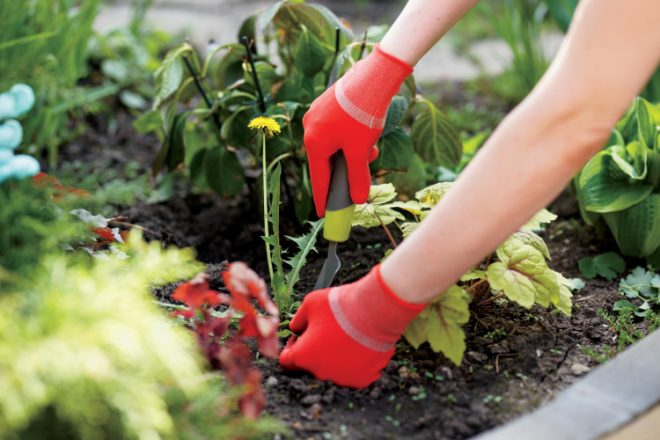
Time spent gardening covers a variety of jobs, but none more time-consuming than weeding. Each plant gets nestled into the soil once. Yet every time it rains, new weeds emerge. Finding ways to minimize the number of weeds slowly helps you gain the upper hand.
Deny weed seeds what they need to germinate. Like any other seed, they depend on sunlight and moisture, and if they don’t receive it, they remain seeds instead of turning into viable plants.
Weed seeds survive under the soil for years – in some cases, decades. The more you cultivate the soil, the more weed seeds you unearth, giving them their time in the sun. Instead of mechanically cultivating the entire vegetable plot, hand-dig each transplant into its spot leaving the soil around it undisturbed.
Keep your gardens covered with organic mulch, effectively blocking out the light. Growing your ornamentals densely packed together (think of a cottage garden) ensures the soil spaces between plants are small and heavily shaded.
You’ll find denying moisture to weed seeds trickier than blocking out the sun. After all, you have no control over the rain. However, you do control supplemental water during dry periods. Water your plants, not the spaces in between them. Skip the sprinklers that get everything uniformly wet, and switch to soaker hoses that target the roots of each plant, but leave the empty spaces dry.
No matter how ruthless you are in preventing weed seeds from germinating, not just some, but many will still find a way to grow. They are weeds, after all. But don’t despair. Your next line of defense: Prevent them from making and dropping new seeds in your landscape.
An old adage says, “pull weeds when it is wet; hoe weeds when it is dry.”
See more: Expert Tips and Insights for Successful Container Gardening
The absolute best time to pull weeds occurs a day or two after rain, depending on how much water you receive. When the soil feels and looks moist, you are more likely to pull out the root, not break off the top leaving the root to regrow a new plant. Keep at it. You’re not just trying to get rid of an eyesore, but to destroy it before it has a chance to propagate and produce even more weeds.
Never hoe wet ground because you will chop the roots into multiple pieces that can each grow a new plant. I assume some gardeners still hoe between the rows of their vegetable gardens, but mulching requires far less work.
Finally, if all else fails and seed heads still appear, lop them off. Do this before they dry and scatter, taking them off site. Do not compost seed heads. Actually, if you are diligent, over time you can kill a weed by repeatedly cutting off anything aboveground. The weed needs a green top for photosynthesis. Deny the weed the ability to feed itself and it will eventually die. This method only works for very persistent gardeners.
Happy weeding!
Ask an Expert
Q. How do I get rid of the destructive moles invading my yard?
A. Move! Or hire a mole trapper. Follow them around to learn what trap is effective, and how and where to set it. If the trapper is successful, next time moles show up, buy the same traps and be your own mole catcher. Poisons don’t work because moles prefer the earthworms in your yard.
Q. What type of mulch do you suggest for vegetable gardens?
A. Grass clippings or straw. The clippings will be gone by next spring, and straw can be reused.



